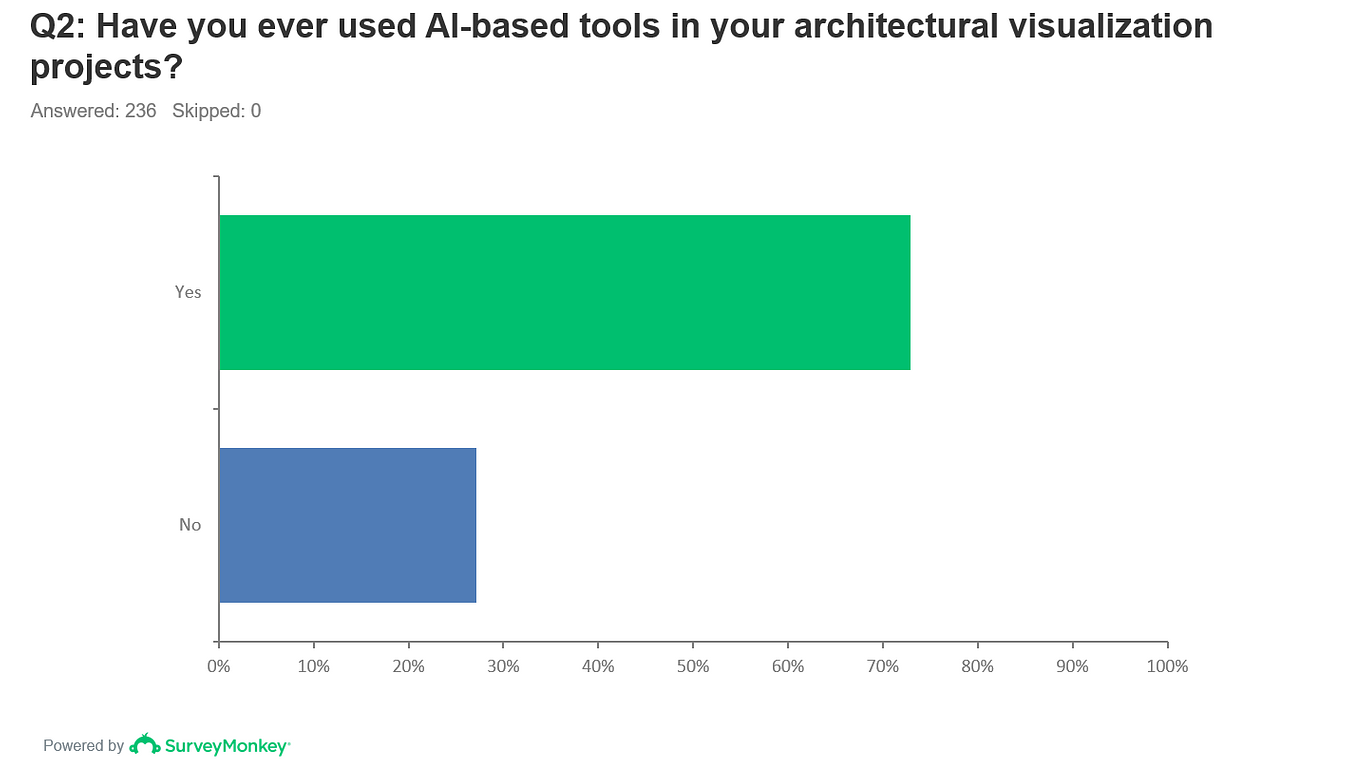
Industry Surveys
AI in Architectural Visualization: 2024 Survey Insights
As AI continues to revolutionize various industries, architectural visualization (archviz) is no exception. Our 2024 CGarchitect Artificial Intelligence Survey has provided us with invaluable insights into how AI is being utilized in the archviz community, highlighting both the benefits and challenges faced by professionals. Here’s a comprehensive breakdown of our findings and what they mean for the industry.
Unless otherwise noted, the results have a Margin of Error of +/- 6% with a Confidence Level of 95%.
Unless otherwise noted, the results have a Margin of Error of +/- 6% with a Confidence Level of 95%.
Familiarity and Adoption of AI
Our survey revealed that a significant portion of the archviz community is familiar with AI technologies. Specifically, 12.29% of respondents consider themselves extremely familiar, while 23.73% are very familiar. The majority, 47.03%, are somewhat familiar, indicating a broad awareness and growing interest in AI.
Interestingly, 72.88% of respondents have already used AI-based tools in their projects. This high adoption rate underscores AI's potential and current impact on archviz workflows. Tools such as Midjourney, Dall-E, and Stable Diffusion are leading the charge, with over half of the respondents using these applications.
It's also worth noting that, in a scale from 1 to 10, repondants rated the overall experience with AI in archviz like being only a 5, clearly showing that although there's plenty of tools available, they are still far from what users would consider ideal.
It's also worth noting that, in a scale from 1 to 10, repondants rated the overall experience with AI in archviz like being only a 5, clearly showing that although there's plenty of tools available, they are still far from what users would consider ideal.
Benefits of AI in Archviz
AI’s integration into archviz has brought several notable benefits. Speed and efficiency are at the forefront, with 66.30% of respondents highlighting speed as a primary advantage, and 46.41% noting improved efficiency. AI also fosters creativity, allowing artists to explore new realms of design and visualization, as 44.75% of our participants noted.
Additionally, AI is seen as enhancing the overall quality of outputs. While only 7.18% of respondents cited accuracy as a primary benefit, the overall improvement in quality was noted by 38.12%, as the vast majority (70%) find AI's post-processing applications the most useful.
Challenges and Areas for Improvement
Despite the enthusiasm, the integration of AI is not without its challenges. Inconsistency in results is a significant concern, reported by 76.80% of respondents. The unpredictable nature of AI outputs can hinder its reliability in professional workflows. Furthermore, 59.12% of respondents find the process involves too much trial and error, and 58.01% express frustration over having little control over final results.
Cost and usability are additional barriers. While 18.23% find AI tools expensive, 13.81% consider them difficult to use. There is a clear call for more predictable, flexible, and user-friendly AI solutions that can seamlessly integrate with existing software.
AI’s Readiness for Production
The survey indicates a split in opinion regarding AI’s readiness for full-scale production use. While 37.57% believe AI is ready, a larger 62.43% feel it is not yet there. This highlights a critical area for developers to address: improving AI reliability and control to meet professional standards consistently. Another very strong point made shows that artists are not really interested in learning a new tool in order to access AI: almost 70% believe AI could be improved to better serve the archviz community by being integrated into the softwares they already use, instead of adding another suite to an already expansive set.
The Future of AI in Archviz
Looking ahead, most respondents (66.47%) believe AI will become just another tool in the archviz toolbox, complementing rather than replacing human creativity. Furthermore, 64.07% predict AI will be absorbed by existing tools, becoming an integral part of daily workflows.
There's a recognition that AI will drive down costs and enhance productivity, with 35.33% expecting significant price reductions and 28.14% expressing concern about job displacement. However, the consensus remains that AI will primarily empower artists, enhancing their capabilities rather than replacing them.
Industry Implications
These findings highlight a transformative period for the archviz industry. AI’s ability to enhance speed, efficiency, and creativity offers immense potential for innovation. However, to fully harness this potential, the industry must address the challenges of inconsistency, control, and usability.
As AI tools become more integrated and user-friendly, we can expect a more seamless workflow, allowing artists to focus on creativity and design. The future of AI in archviz looks promising, poised to redefine how we visualize and create architectural masterpieces.
In conclusion, while AI is still evolving, its impact on the archviz industry is undeniable. As we continue to adapt and integrate these technologies, the potential for innovation and efficiency in our work grows exponentially. The key will be to balance AI’s capabilities with human creativity, ensuring that we harness these tools to enhance, not overshadow, the artistry at the heart of architectural visualization.
You can download the full report, for free, here.
You can download the full report, for free, here.
You must be logged in to post a comment. Login here.
About this article
Our 2024 CGarchitect Artificial Intelligence Survey has provided us with invaluable insights into how AI is being utilized in the archviz community, highlighting both the benefits and challenges faced by professionals. Here’s a comprehensive breakdown of our findings and what they mean for the industry.
visibility689
favorite_border2
mode_comment0







